2017 Nepalese general election
General elections were held in Nepal in two phases on 26 November and 7 December 2017 to elect the 275 members of the fifth House of Representatives, the lower house of the Federal Parliament of Nepal.[1] The election was held alongside the first provincial elections for the seven provincial assemblies. A political deadlock between the governing Nepali Congress and the winning left-wing coalition over the system used to elect the upper house led to delay in forming the new government.[2] Following the announcement of final result by the Election Commission, K.P. Oli of Communist Party of Nepal (Unified Marxist–Leninist) was sworn in as Prime Minister on 15 February 2018 by the President according to Article 76 (2) of the constitution. He passed a Motion of Confidence on 11 March 2018 with 208 votes.[3]
 | |||||||||||||||||||||||||||||||||||||||||||||||||||||||||||||||||||||||||||||||||||||||||
| |||||||||||||||||||||||||||||||||||||||||||||||||||||||||||||||||||||||||||||||||||||||||
All 275 seats in the House of Representatives 138 seats needed for a majority | |||||||||||||||||||||||||||||||||||||||||||||||||||||||||||||||||||||||||||||||||||||||||
|---|---|---|---|---|---|---|---|---|---|---|---|---|---|---|---|---|---|---|---|---|---|---|---|---|---|---|---|---|---|---|---|---|---|---|---|---|---|---|---|---|---|---|---|---|---|---|---|---|---|---|---|---|---|---|---|---|---|---|---|---|---|---|---|---|---|---|---|---|---|---|---|---|---|---|---|---|---|---|---|---|---|---|---|---|---|---|---|---|---|
| Registered | 15,427,731 | ||||||||||||||||||||||||||||||||||||||||||||||||||||||||||||||||||||||||||||||||||||||||
| Turnout | 10,587,521 (68.63%) | ||||||||||||||||||||||||||||||||||||||||||||||||||||||||||||||||||||||||||||||||||||||||
| |||||||||||||||||||||||||||||||||||||||||||||||||||||||||||||||||||||||||||||||||||||||||
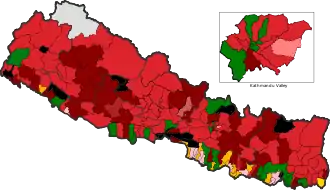 A map of Nepal parliamentary constituencies | |||||||||||||||||||||||||||||||||||||||||||||||||||||||||||||||||||||||||||||||||||||||||
| |||||||||||||||||||||||||||||||||||||||||||||||||||||||||||||||||||||||||||||||||||||||||
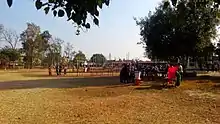
Background
The previous House of Representatives, elected in May 1999, was dissolved by Gyanendra on advice of Prime Minister Sher Bahadur Deuba in May 2002 in order to hold new elections. Elections could not take place due to the ongoing civil war which eventually led King Gyanendra to stage a royal coup in February 2005 after dismissing four Prime Ministers. Following the democracy movement of 2006, the King reinstated the earlier legislature. On 15 January 2007, the House of Representatives was replaced by an Interim Legislature. The Interim Legislature consisted both of members appointed by an agreement between the Seven Party Alliance and the Communist Party of Nepal (Maoist).
The Interim Legislature was followed by the first Constituent Assembly whose task was to form a new constitution. The failure of the assembly to write a constitution within the stipulated time led to the formation of the second Constituent Assembly which approved the Constitution of Nepal on 20 September 2015. After the promulgation of constitution, the second Constituent Assembly was converted into a unitary Legislature Parliament. The constitution set the tenure of the Legislature Parliament until 21 January 2018 or the date of filing of nomination for the House of Representatives, whichever is earlier.[4] Per this provision, the tenure of the Legislature Parliament ended on 14 October 2017.
A five-member Constituency Delineation Commission was formed under the chairmanship of former Supreme Court Justice Kamal Narayan Das to redraw the constituency boundaries to 165, a reduction from the 240 used in the 2013 elections. It submitted its report to the government on 30 August 2017.[5] The boundaries set by this commission will remain unchanged for the next 20 years as per Article 286 (12).
Electoral system
The 275 members of the legislature were elected by two methods; 165 were elected from single-member constituencies by first-past-the-post voting and 110 seats were elected by closed list proportional representation from a single nationwide constituency.[6] Each voter received separate ballot papers for the two methods. A party or electoral alliance had to pass the election threshold of 3% of the overall valid vote to be allocated a seat under the proportional method.[7]
Eligibility to vote
To vote in the general election, one must be:[8]
- on the electoral roll
- aged 18
- a citizen of Nepal
- of sound mind
- not ineligible as per federal election fraud and punishment laws
Timetable
The key dates are listed below
| 19 August | Last day to register to be on electoral roll[9] |
| 21 August | Cabinet announces election date |
| 27 August | Last day for party registration at Election Commission[10] |
| 30 August | Election code of conduct starts |
| 14 October | Tenure of Legislature parliament ends |
| 15 October | Parties submit preliminary closed list for proportional representation |
| 22 October | Candidate nomination for first phase of first past the post |
| 2 November | Candidate nomination for second phase of first past the post |
| 19 November | Closed list for proportional representation finalized and published |
| 26 November | Election day (first phase) – polling centres open 07:00 to 17:00 |
| 7 December | Election day (second phase) – polling centres open 07:00 to 17:00 |
| 14 February | Final result announced and presented to President |
Parties and alliances
A total of 88 parties were granted ballot access under the proportional system. However, only 49 parties submitted list of proportional candidates.[11]
A left alliance comprising the Communist Party of Nepal (Unified Marxist–Leninist), the Communist Party of Nepal (Maoist Centre) and the Naya Shakti Party was announced with party unification to follow after the elections.[12] However, Naya Shakti Party left the alliance after its coordinator Baburam Bhattarai was not guaranteed an election ticket from his preferred constituency of Gorkha. He subsequently switched alliances in Gorkha. Other leftist parties like Rastriya Janamorcha and Communist Party of Nepal (Marxist–Leninist) have also joined this alliance in some constituencies.[13]
An alliance consisting of the center-left Nepali Congress, the Rastriya Prajantanra Party, the Rastriya Prajantanra Party (Democratic) and two Madhesh based parties, Federal Socialist Forum, Nepal and Rastriya Janata Party Nepal, was formed as a response to this left alliance but was limited to select places.[14] Rastriya Prajatantra Party allied with the left parties to defeat Nepali Congress candidate former Home Minister Krishna Prasad Sitaula in Jhapa-3.[15]
Conduct
Before the final phase of the election, starting 5 December, the border with India was closed at 22 points.[16] There have been over a hundred minor and major explosions in the run up to the elections targeting election assemblies and leaders.[17] A temporary police was killed in Dang from an explosion at an event attended by the Prime Minister.[18] Nepali Congress candidate Narayan Karki was injured in a targeted explosion to his vehicle in Udayapur while 11 people including former Health Minister Gagan Thapa were injured from an explosion in Kathmandu.[19]
Results
Five parties, CPN (Unified Marxist-Leninst), Nepali Congress, CPN (Maoist Centre), Rastriya Janata Party and Federal Socialist Forum, won at least one seat in first-past-the-post voting and crossed the three percent in proportional voting and were represented in the parliament. Rastriya Prajatantra Party, Naya Shakti Party, Rastriya Janamorcha and Nepal Workers Peasants Party did not reach the three percent threshold in proportional voting and were represented as independents in the parliament.
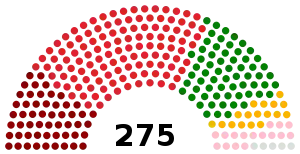 | ||||||||
| Party | Constituency | Proportional | Total seats | |||||
|---|---|---|---|---|---|---|---|---|
| Votes | % | Seats | Votes | % | Seats | |||
| CPN (Unified Marxist–Leninist) | 3,082,277 | 30.68 | 80 | 3,173,494 | 33.25 | 41 | 121 | |
| Nepali Congress | 3,590,793 | 35.75 | 23 | 3,128,389 | 32.78 | 40 | 63 | |
| CPN (Maoist Centre)[lower-alpha 1] | 1,510,760 | 15.03 | 36 | 1,303,721 | 13.66 | 17 | 53 | |
| Samajbadi Janata Party[lower-alpha 1] | – | – | – | |||||
| Janajagaran Party, Nepal[lower-alpha 1] | – | – | – | |||||
| Rastriya Janata Party Nepal | 458,409 | 4.56 | 11 | 472,254 | 4.95 | 6 | 17 | |
| Federal Socialist Forum, Nepal | 527,924 | 5.26 | 10 | 470,201 | 4.93 | 6 | 16 | |
| Bibeksheel Sajha Party | 96,233 | 0.96 | 0 | 212,366 | 2.22 | 0 | 0 | |
| Rastriya Prajatantra Party | 118,318 | 1.18 | 1 | 196,782 | 2.06 | 0 | 1 | |
| Rastriya Prajatantra Party (Democratic) | 123,797 | 1.23 | 0 | 88,377 | 0.93 | 0 | 0 | |
| Naya Shakti Party, Nepal | 84,037 | 0.84 | 1 | 81,837 | 0.86 | 0 | 1 | |
| Rastriya Janamorcha | 70,014 | 0.70 | 1 | 62,133 | 0.65 | 0 | 1 | |
| Nepal Workers Peasants Party | 52,668 | 0.52 | 1 | 56,141 | 0.59 | 0 | 1 | |
| Communist Party of Nepal (Marxist–Leninist)[lower-alpha 2] | 69,115 | 0.69 | 0 | 41,270 | 0.43 | 0 | 0 | |
| Jana Samajbadi Party, Nepal[lower-alpha 2] | 13,067 | 0.14 | 0 | |||||
| Nepal Federal Socialist Party | 19,064 | 0.19 | 0 | 36,015 | 0.38 | 0 | 0 | |
| Rastriya Janamukti Party | 27,279 | 0.27 | 0 | 33,091 | 0.35 | 0 | 0 | |
| Ekikrit Rastriya Prajatantrik Party (Nationalist) | 34,765 | 0.35 | 0 | 28,835 | 0.30 | 0 | 0 | |
| Nepali Janata Dal | 8,750 | 0.09 | 0 | 22,049 | 0.23 | 0 | 0 | |
| Sanghiya Loktantrik Rastriya Manch | 17,017 | 0.17 | 0 | 21,610 | 0.23 | 0 | 0 | |
| Bahujan Shakti Party | 10,382 | 0.10 | 0 | 15,468 | 0.16 | 0 | 0 | |
| Mongol National Organization | 16,500 | 0.16 | 0 | 15,117 | 0.16 | 0 | 0 | |
| Sanghiya Loktantrik Rastriya Manch (Tharuhat) | 121 | 0.00 | 0 | 14,489 | 0.15 | 0 | 0 | |
| Patriotic People's Republican Front | 19,884 | 0.20 | 0 | 13,942 | 0.15 | 0 | 0 | |
| Nepal Janata Party | 3,387 | 0.03 | 0 | 9,310 | 0.10 | 0 | 0 | |
| Janashakti Nepal | – | – | – | 7,981 | 0.08 | 0 | 0 | |
| Aamul Pariwartan Masiha Party Nepal | 793 | 0.00 | 0 | 5,161 | 0.05 | 0 | 0 | |
| Rastriya Mukti Andolan Nepal | 1,550 | 0.02 | 0 | 4,275 | 0.04 | 0 | 0 | |
| Nepa Rastriya Party | 206 | 0.00 | 0 | 3,460 | 0.04 | 0 | 0 | |
| Nepal Loktantrik Janata Congress | 815 | 0.00 | 0 | 2,389 | 0.03 | 0 | 0 | |
| Churebhavar Loktantrik Party | 475 | 0.00 | 0 | 2,170 | 0.02 | 0 | 0 | |
| Green Party Nepal | 334 | 0.00 | 0 | 1,685 | 0.02 | 0 | 0 | |
| Nepal Samabeshi Party | – | – | – | 1,676 | 0.02 | 0 | 0 | |
| Nepali Congress (B.P.) | 2,679 | 0.03 | 0 | 1,608 | 0.02 | 0 | 0 | |
| Nepalwad | 37 | 0.00 | 0 | 1,547 | 0.02 | 0 | 0 | |
| Nepal Sukumbasi Party (Democratic) | – | – | – | 1,456 | 0.02 | 0 | 0 | |
| Communist Party of Nepal (Marxist) | 1,440 | 0.01 | 0 | 1,420 | 0.01 | 0 | 0 | |
| Tamangsaling Loktantrik Party | 77 | 0.00 | 0 | 1,397 | 0.01 | 0 | 0 | |
| Nepal Yuwa Kisan Party | 1,033 | 0.01 | 0 | 1,334 | 0.01 | 0 | 0 | |
| Rastriya Samajwadi Party, Nepal | 366 | 0.00 | 0 | 1,053 | 0.01 | 0 | 0 | |
| Nepal Darshan | – | – | – | 1,052 | 0.01 | 0 | 0 | |
| Rastriya Yatharthawadi Party, Nepal | 502 | 0.00 | 0 | 977 | 0.01 | 0 | 0 | |
| Nepal Naulo Janwadi Party | 75 | 0.00 | 0 | 976 | 0.01 | 0 | 0 | |
| Rastriya Shiva Sena Party[lower-alpha 3] | 157 | 0.00 | 0 | 946 | 0.01 | 0 | 0 | |
| Rastriya Nagarik Party[lower-alpha 3] | 25 | 0.00 | 0 | |||||
| Yuwa Nepal Party | 137 | 0.00 | 0 | 872 | 0.01 | 0 | 0 | |
| Nepal Dalit Party | 1,092 | 0.01 | 0 | 834 | 0.01 | 0 | 0 | |
| Sanghiya Khumbuwan Democratic Party Nepal | 408 | 0.00 | 0 | 744 | 0.01 | 0 | 0 | |
| Deshbhakta Loktantrik Party | 1,289 | 0.01 | 0 | 740 | 0.01 | 0 | 0 | |
| Janaprajatantrik Party, Nepal | 138 | 0.00 | 0 | 721 | 0.01 | 0 | 0 | |
| Liberal Democratic Party | 259 | 0.00 | 0 | 519 | 0.01 | 0 | 0 | |
| Deshbhakta Samaj | 92 | 0.00 | 0 | 434 | 0.00 | 0 | 0 | |
| Hamro Party | 89 | 0.00 | 0 | 426 | 0.00 | 0 | 0 | |
| Nepal Loktantrik Janata Congress | 815 | 0.00 | 0 | – | – | – | 0 | |
| Bahujan Samaj Party Nepal | 708 | 0.00 | 0 | – | – | – | 0 | |
| Dalit, Muslim Janashakti Party | 544 | 0.00 | 0 | – | – | – | 0 | |
| Rastriya Yatharthabadi Party Nepal | 502 | 0.00 | 0 | – | – | – | 0 | |
| Lok Kalyankari Janata Party Nepal | 496 | 0.00 | 0 | – | – | – | 0 | |
| Rastriya Samajbadi Party Nepal | 366 | 0.00 | 0 | – | – | – | 0 | |
| Madhesh Terai Forum | 152 | 0.00 | 0 | – | – | – | 0 | |
| Nepali Greens | 78 | 0.00 | 0 | – | – | – | 0 | |
| Muskan Sena Nepal | 22 | 0.00 | 0 | – | – | – | 0 | |
| Independents | 73,243 | 0.73 | 1 | – | – | – | 1 | |
| Invalid/blank votes | – | – | – | – | – | |||
| Total | 10,045,555 | 100 | 165 | 9,544,744 | 100 | 110 | 275 | |
| Registered voters/turnout | – | – | – | |||||
| Source: Election Commission | ||||||||
Aftermath
The governing Nepali Congress preferred the upper house to be elected by Single Transferable Voting System while the left parties preferred majority vote. Lack of consensus meant the Legislature Parliament disbanded on 14 October, as required by the constitution, without approving National Assembly Election Bill which included provisions to elect members of the upper house.[20]
According to Article 84 (8) of the Constitution of Nepal, at least one third of the total number of members elected to the Federal Parliament from each party must be women. Citing this provision, the Election Commission withheld announcing final results as the number of women each party needs to submit from their respective party lists could not be determined until the number of women in the upper house from each party was confirmed.
The government sent the National Assembly Election Ordinance to the President on 23 October 2017 with the provision that the upper house be elected using Single Transferable Voting System.[21] The ordinance was held by the president for two months citing lack of consensus, but was ultimately approved on 29 December 2017.[22] Another delay occurred because the electoral college for the election of the upper house includes members of the State Assemblies who, due to the absence of Chiefs of State, had not been able to take the oath of office until late January.
Notes
- CPN (Maoist Centre), Samajbadi Janata Party and Janajagaran Party, Nepal contested under the same election symbol in proportional voting
- Communist Party of Nepal (Marxist-Leninist) and Jana Samajbadi Party, Nepal contested under the same election symbol in proportional voting
- Rastriya Shiva Sena Party and Rastriya Nagarik Party contested under the same election symbol in proportional voting
See also
References
- "Govt decides to hold provincial, parliamentary polls in two phases". The Himalayan Times. International Media Network Nepal (Pvt) Ltd. Retrieved 31 August 2017.
- Baral, Biswas. "Why Nepal Is Still Caught in a Political Deadlock Over the Formation of Its New Government". The Wire. Foundation for Independent Journalism. Retrieved 3 January 2018.
- "प्रधानमन्त्री ओलीका पक्षमा ७५ प्रतिशत सांसद". Setopati. Retrieved 11 March 2018.
- Article 296 Constitution of Nepal
- Giri, Sanjeev. "CDC submits its report with 165 electoral constituencies". The Kathmandu Post. Kantipur Publications. Retrieved 31 August 2017.
- Article 84 Constitution of Nepal
- Kafle, Narayn (5 September 2017). "संसद् र प्रदेशको निर्वाचन विधेयक पारित". Gorkhapatra. Gorkhapatra Sansthan. Retrieved 6 September 2017.
- "Electoral Roll Act, 2017". Article 6 & 23, Act No. 23 of 2 February 2017 (PDF) (in Nepali). Archived from the original (PDF) on 5 September 2017. Retrieved 5 September 2017.
- "प्रेश विज्ञप्ति" [Press release] (Press release) (in Nepali). Kathmandu: Election Commission. Retrieved 2017-09-03.
- "दल दर्ता गर्न आयोगमा ९५ वटा निवेदन". Gorkhapatraonline. Gorkhapatra Sansthan. Retrieved 3 September 2017.
- "49 parties file closed list of PR candidates". The Himalayan Times. International Media Network Nepal (Pvt) Ltd. Retrieved 15 December 2017.
- "Art of the impossible". Himalmedia. Retrieved 5 October 2017.
- "बाम गठबन्धनलाई जनमोर्चाले सघाउने". Nagarik News. Nepal Republic Media. Retrieved 9 November 2017.
- Dangal, Dhruba. "लोकतान्त्रिक गठबन्धनमा उत्साह". NagarikNews. Nepal Republic Media. Retrieved 25 October 2017.
- "NC, RPP say alliance intact savefor Jhapa-3". The Himalayan Times. Retrieved 15 December 2017.
- "Nepal closes border with India for 72 hours ahead of December 7 elections". Hindustan Times. New Delhi. 5 December 2017. Retrieved 7 December 2017.
- Ghimire, Yubaraj. "Bomb attacks rock landmark Nepal polls". The Indian Express. Retrieved 4 December 2017.
- "NC aggrieves death of temporary police in blast in Dang". The Himalayan Times. International Media Network Nepal (Pvt) Ltd. Retrieved 4 December 2017.
- Bohara, Rameshwar. "विष्फोट श्रृंखलाः के सरकारमाथि नै शंका गर्नुपर्ने हो ?". Himal Khabar. Himalmedia Pvt. Ltd. Retrieved 4 December 2017.
- "संसदको आयु सकिएसँग १९ विधेयक पनि निश्क्रिय". Dainik Nepal. Retrieved 3 January 2018.
- Row over National Assembly drags on Myrepublica
- "President authenticates National Assembly Election Ordinance". My Republica. Retrieved 1 January 2018.
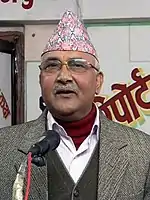
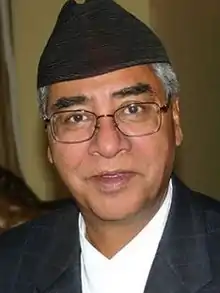
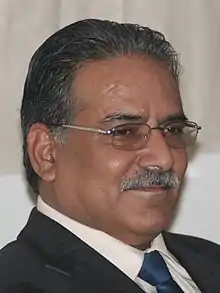
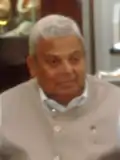
.jpg.webp)
